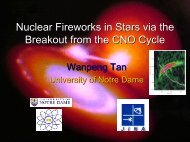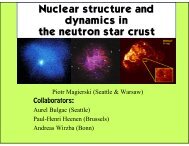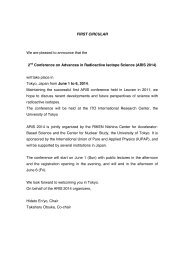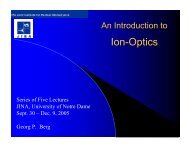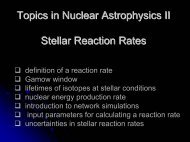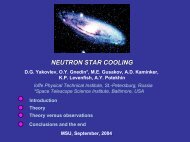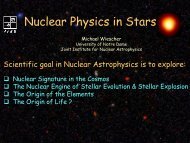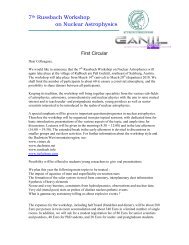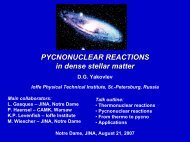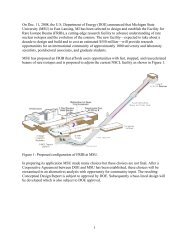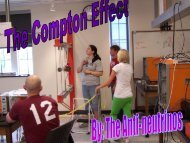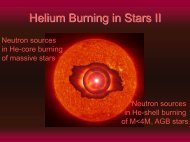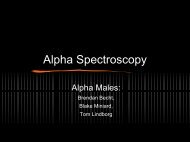OPPORTUNITIES IN NUCLEAR SCIENCE A Long-Range Plan for ...
OPPORTUNITIES IN NUCLEAR SCIENCE A Long-Range Plan for ...
OPPORTUNITIES IN NUCLEAR SCIENCE A Long-Range Plan for ...
You also want an ePaper? Increase the reach of your titles
YUMPU automatically turns print PDFs into web optimized ePapers that Google loves.
OVERVIEW AND RECOMMENDATIONS<br />
be initiated during the planning period, even within the constraints<br />
of a tight budget; (ii) medium-sized initiatives, such<br />
as major facility upgrades; and (iii) projects of such a scale<br />
that they represent a major reshaping of the field. In any<br />
decade, we would expect no more than one project of this<br />
last sort to be initiated. Prioritization of the initiatives discussed<br />
at the Santa Fe meeting provided the basis <strong>for</strong> the<br />
next three recommendations.<br />
RECOMMENDATION 2<br />
The Rare Isotope Accelerator (RIA) is our highest priority<br />
<strong>for</strong> major new construction. RIA will be the<br />
world-leading facility <strong>for</strong> research in nuclear structure<br />
and nuclear astrophysics.<br />
The exciting new scientific opportunities offered by<br />
research with rare isotopes are compelling. RIA is<br />
required to exploit these opportunities and to ensure<br />
world leadership in these areas of nuclear science.<br />
RIA will require significant funding above the<br />
nuclear physics base. This is essential so that our<br />
international leadership positions at CEBAF and at<br />
RHIC be maintained.<br />
from protons to uranium at energies of at least 400 MeV per<br />
nucleon, with beam power greater than 100 kW. It will provide<br />
higher intensities of radioactive beams than any present<br />
or planned facility, worldwide. This wealth of isotopes promises<br />
a wide variety of applications in basic sciences, applied<br />
sciences, and medicine.<br />
RECOMMENDATION 3<br />
We strongly recommend immediate construction of the<br />
world’s deepest underground science laboratory. This<br />
laboratory will provide a compelling opportunity <strong>for</strong><br />
nuclear scientists to explore fundamental questions in<br />
neutrino physics and astrophysics.<br />
Recent evidence <strong>for</strong> neutrino mass has led to new<br />
insights into the fundamental nature of matter and<br />
energy. Future discoveries about the properties of<br />
neutrinos will have significant implications <strong>for</strong> our<br />
understanding of the structure of the universe. An<br />
outstanding new opportunity to create the world’s<br />
deepest underground laboratory has emerged. This<br />
facility will position the U.S. nuclear science community<br />
to lead the next generation of solar neutrino and<br />
double-beta-decay experiments.<br />
The scientific justification <strong>for</strong> RIA has three broad themes:<br />
• Investigations into the nature of nucleonic matter.<br />
RIA will define and map the limits of nuclear existence<br />
and allow us to explore the quantum mechanical<br />
structure of the exotic many-body systems that may<br />
be found near those limits.<br />
• A quest to understand the origin of the elements and<br />
the generation of energy in stars. RIA will provide<br />
key data, such as masses, lifetimes, and reaction<br />
rates, needed <strong>for</strong> a quantitative understanding of the<br />
important nucleosynthesis processes, especially the<br />
r-process, by which much of the material around us<br />
was produced.<br />
• Tests of fundamental conservation laws. RIA’s unique<br />
capabilities, including the ability to create exotic nuclei,<br />
which can then be trapped, will permit sensitive tests of<br />
basic symmetries and other important aspects of the<br />
electroweak interaction.<br />
The key to achieving these goals is RIA’s driver accelerator,<br />
which will be a flexible device capable of providing beams<br />
A National Underground Science Laboratory (NUSL)<br />
will house experiments not only to answer significant<br />
nuclear physics questions, but also to address key issues in<br />
the related fields of particle physics, astrophysics, and cosmology.<br />
A wider science program at NUSL is also anticipated,<br />
including research in geology and microbiology, and<br />
applied ef<strong>for</strong>ts relevant to industry and national defense.<br />
Many next-generation experiments in all these fields must<br />
be substantially more sensitive than current ones and thus<br />
require shielding that can only be provided by working at<br />
great depth underground. It is highly advantageous, there<strong>for</strong>e,<br />
that a new laboratory be deeper than existing facilities<br />
in Japan and Europe.<br />
The Homestake mine in South Dakota offers an ideal<br />
location <strong>for</strong> NUSL, with available experimental sites<br />
between 2100 and 7200 meters (water equivalent) below<br />
the surface. A proposal <strong>for</strong> the development of NUSL at<br />
Homestake has been submitted to the NSF, and ef<strong>for</strong>ts are<br />
under way <strong>for</strong> the state of South Dakota to assume ownership<br />
of the mine. A second potential site, at San Jacinto in<br />
Cali<strong>for</strong>nia, has also been identified.<br />
8



